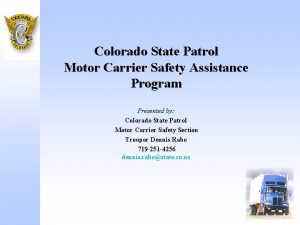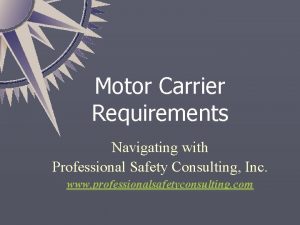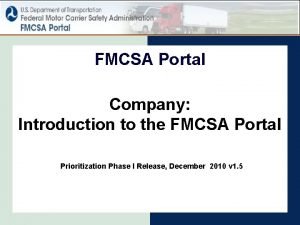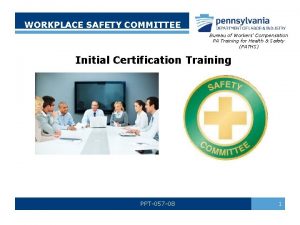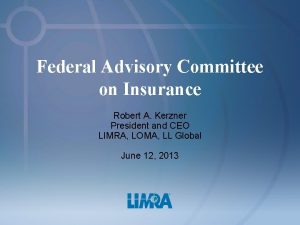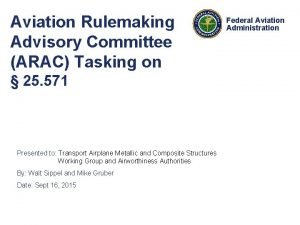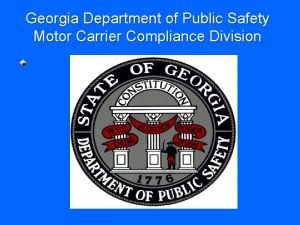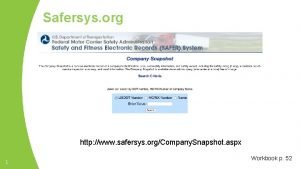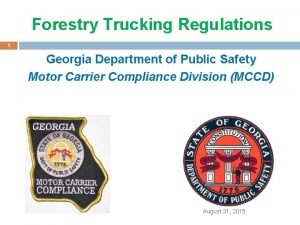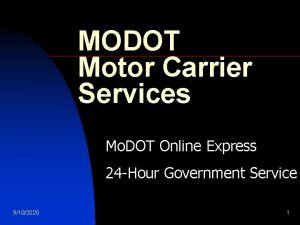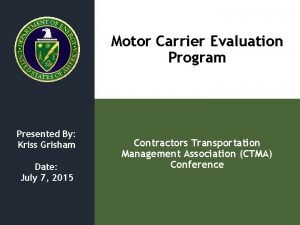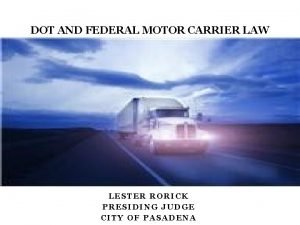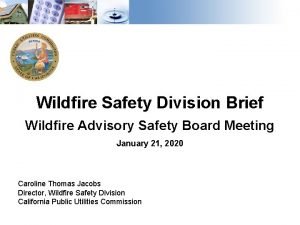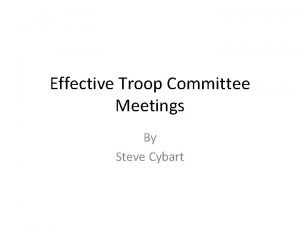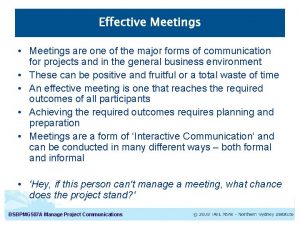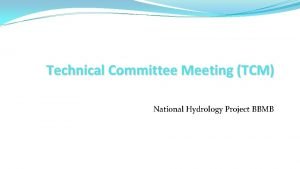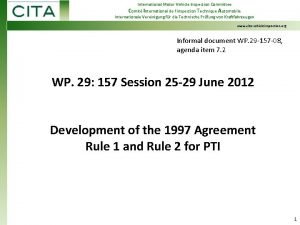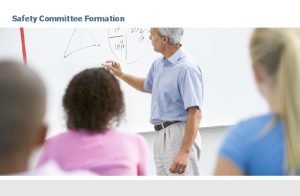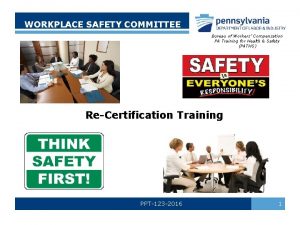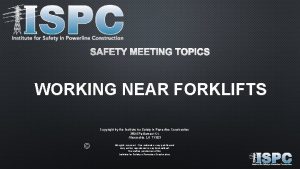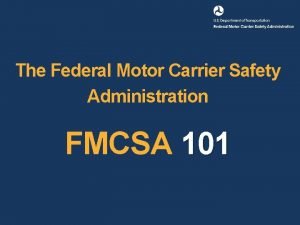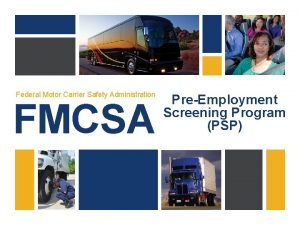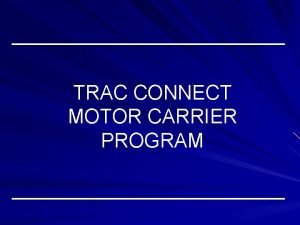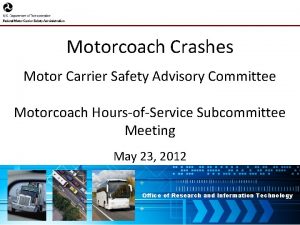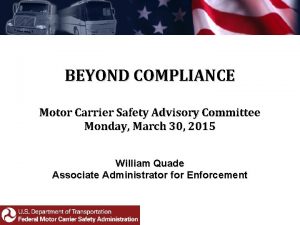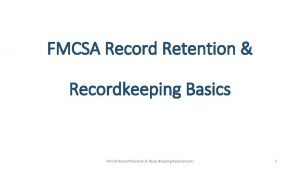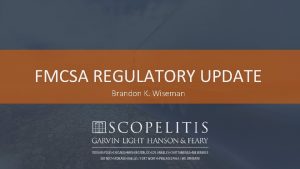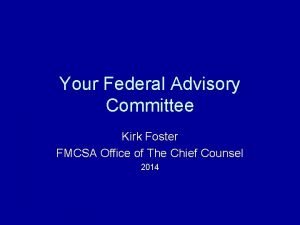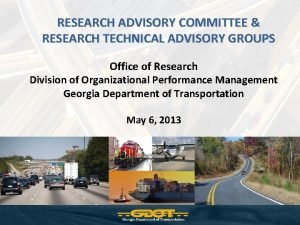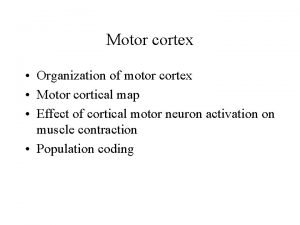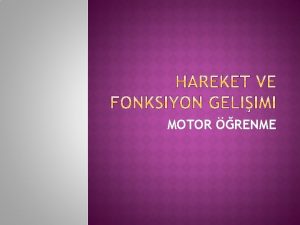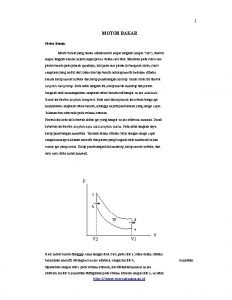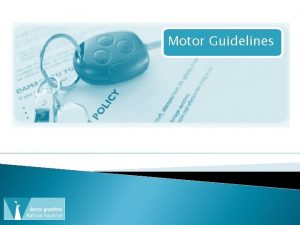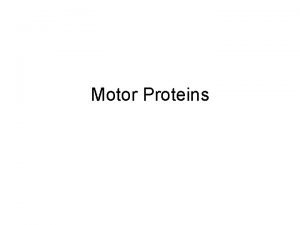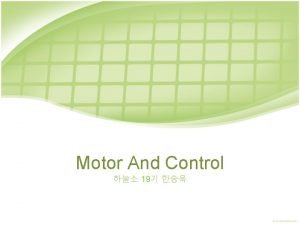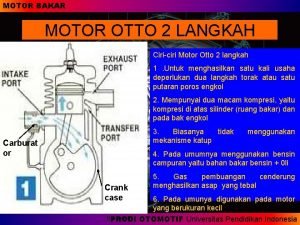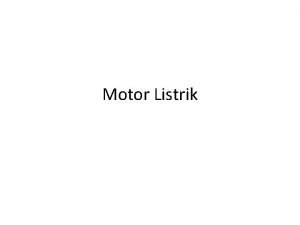Motor Carrier Safety Advisory Committee Meeting FMCSA Research

































- Slides: 33

Motor Carrier Safety Advisory Committee Meeting FMCSA Research Portfolio June 2015 Office of Research and Information Technology

Presentation Overview § FMCSA’s Safety Research and Technology (R&T) Program. 1. Produce Safe Drivers. 2. Support Safe Carrier Operations. 3. Assess Safety Technologies. § Future Research Areas. Office of Research and Information Technology 1

Large Truck and Bus Fatal Crashes, 2013 Source: National Highway Traffic Safety Administration (NHTSA), Fatality Analysis Reporting System (FARS). Office of Research and Information Technology 2

Locations of Carriers by Domicile, 2013 Office of Research and Information Technology 3

FMCSA Research and Technology Goals § § § Understand the causes of crashes. Reduce driver fatigue. Improve driver training. Provide analysis for Agency rulemaking. Identify best practices for the trucking and motorcoach industry. § Assess technology and innovative tools to improve safety. Office of Research and Information Technology 4

R&T Project Development Process Office of Research and Information Technology 5

Strategic Research Areas 1. Produce Safer Drivers. 2. Support Safe Carrier Operations. 3. Assess Safety Technologies. Office of Research and Information Technology 6

1. Produce Safe Drivers § Naturalistic driving studies. § Driver health. § Sleep and driver fatigue. Office of Research and Information Technology 7

Naturalistic Driving Studies § Provides in-vehicle, real-time objective video identifying driver performance and crash precursors. § Truck cab equipped with video cameras to provide view of driver’s face, forward view, and two side mirror views. § Data provides better understanding of precursors to crashes and driver performance, inattention, distraction, and fatigue. § Potential causes of crashes and potential The four camera views. countermeasures. Office of Research and Information Technology 8

CMV Driver Restart Study Office of Research and Information Technology 9

CMV Driver Restart Study – Background: § The Consolidated and Further Continuing Appropriations Act of 2015 directed FMCSA to conduct a CMV Driver Restart Study. § Study to measure and compare the fatigue and safety performance levels of drivers who use the two provisions of the HOS rule. § Driver recruitment is completed, and data collection is underway. Office of Research and Information Technology 10

CMV Driver Restart Study – Overview § Compare driver work schedules to assess safety critical events, operator fatigue, and driver health using: § Electronic Logging Devices (ELDs). § Psychomotor Vigilance Tasks (PVTs): § A PVT is a reaction test (administered via a smartphone) which measures alertness. § Actigraph Watches: § Actigraph watches are devices that are worn on the wrist. These devices monitor drivers’ sleep patterns and sometimes other health measures, such as heart rate. § Onboard Monitoring Systems (OBMSs). § Study includes drivers from fleets of all sizes (small, medium, and large) and operations (including long-haul, regional, and short-haul) in various sectors of the industry (including flat-bed, refrigerated, tank, and dry-van). Office of Research and Information Technology 11

Flexible Sleeper Berth Pilot Program Photo Credit: Rennett Stowe (Flickr) Office of Research and Information Technology 12

Flexible Sleeper Berth Pilot Program § Background: § Study results suggest that split sleep is preferable to consolidated daytime sleep (if consolidated nighttime sleep is not an option). § FMCSA is establishing a Flexible Sleeper Berth Pilot Program, as specified in 49 CFR Section 381. 400. This Pilot Program will: § Allow the Agency to evaluate alternatives to the regulations, ensuring that safety goals are satisfied. § Provide temporary regulatory relief from the sleeper berth provision for participants, allowing some flexibility for drivers to split sleep when tired. § Status: Pilot Program is scheduled to begin later in 2015. Office of Research and Information Technology 13

2. Support Safe Carrier Operations § Driver Detention Times. § Onboard Monitoring Systems (OMBS). Office of Research and Information Technology 14

Driver Detention Times Study: Phases I and II § Goal: To better understand issues with driver detention and to develop strategies to help mitigate driver risk. § Approximately 4 percent of drivers reported that they had driven beyond the legal hours of service (HOS) limits due to detention time. § Carriers reported that approximately 12 percent of deliveries experienced some detention time. § Two Phases: § Phase 1: Methodology developed. Final report published on FMCSA website. § Phase 2: Evaluate the safety and operational impacts of driver detention time on work hours, HOS, violations, and crashes. Office of Research and Information Technology 15

OBMS Systems Research Goal: To determine whether onboard monitoring of driver performance and feedback (real-time and delayed) can improve driver behavior and CMV safety. Office of Research and Information Technology 16

OBMS Data Acquisition System Office of Research and Information Technology 17

3. Assess Safety Technologies § Advanced Roadside Inspection Technology. § Wireless Roadside Inspection (WRI). § International Border Crossing e-Screening (IBCE). § Alternative fuels. § Onboard safety systems. § Vehicle Automation. § Autonomous CMV vehicles. § Low speed seaport application. § Wireless Automatic Braking Systems (ABS) Assessment. § Electronic Logging Device (ELD) Test Procedures. Office of Research and Information Technology 18

WRI – Overview § Assessment: § Fixed and mobile sites, of driver, carrier, and vehicle compliance via secure wireless communications while the CMV is traveling. § Phase 3 – Field Operational Test: § Maximum of 1, 000 vehicles. § Multiple fleets. § Testing in Commercial Motor Vehicle Roadside Technology Consortium (CMVRTC) States: Georgia, Kentucky, Mississippi, North Carolina, and Tennessee. § 20 inspection sites identified for data collection. Office of Research and Information Technology 19

WRI – Impacts on Compliance, Safety, Accountability Behavior Analysis and Safety Improvement Categories (BASICs) Unsafe Driving Crash Indicator HOS Compliance SMS WRI can likely have an effect on two of the BASICs Driver Fitness HM Compliance Controlled Substances/ Alcohol Vehicle Maintenance Office of Research and Information Technology 20

IBCES Functionality § Secure, cloud-based e-Screening delivers safety clearance checks directly to roaming inspectors on handheld tablets. § Application shows arriving trucks, their identification, and their clearance check results. § Secure, Web-based application supports scrolling, filtering and sorting of results. Office of Research and Information Technology 21

BSA Inspector Interface Field Test Version Report for Each Arriving Tractor Identified by CBP License Plate and USDOT Number Identification E-Screening Clearance Checks § § Office of Research and Information Technology Three Phases § Check Mark– Pass § Strikethrough – No data available § “Universal No” Symbol - Fail Carrier § OA - U. S. Operating Authority § OOS - Out of Service § L&I - Insurance § ISS - Safety score Tractor § CVSA – Current CVSA decal Driver § CDL – Current CDL or equiv. § HZ - HAZMAT endorsements 22

Alternative Fuels: Program Overview § Hydrogen (H 2) § Piloted safety awareness training for drivers of electric-battery drayage trucks with H 2 fuel-cell range extender at Long Beach Community College, 07/2013. § Natural Gas § Published recommendations for FMCSRs, North American Standard (NAS) Inspection Procedures, and Out-Of-Service (OOS) Criteria in 05/2015. § Piloted a training class for inspectors to detect leaks in trucks in 09/2014; web-based training to be posted. § Electric & Hybrid-Electric § Final Report to recommend updates for FMCSRs, NAS Inspection Procedures, and OOS Criteria. § Plan to develop training for inspectors to check for high-voltage hazards. Office of Research and Information Technology 23

Vehicle Automation – Autonomous CMV Vehicles § Goal: To better understand the impacts that autonomous vehicles will have on Federal regulations and safety. Ø Develop a research roadmap to encourage technology and to identify impacted Federal Motor Carrier Safety Regulations (FMCSRs). § Background: Autonomous vehicles could greatly improve CMV safety by reducing driver error and reducing congestion by moving trucks to off-peak periods. Office of Research and Information Technology 24

Low Speed Automated Truck Queue at Ports and Warehouses § Goal: To evaluate the cost/benefit of automated truck movement in queues at ports and warehouses. § Technology scan of existing or near-term enabling technologies, cost estimation, and safety benefits. § Feasibility Study of automated truck movement at ports and warehouses allowing drivers to be "off-duty" while waiting for loading and unloading. § Background: Drivers in CMVs waiting in line or queues for unloading and loading at port terminals and warehouses are in "on-duty" driving status and therefore can incur productivity losses. Office of Research and Information Technology 25

Wireless ABS Assessment § Goal: To develop a cost effective diagnostic tool for enforcement personnel to diagnose and enforce properation of the anti-lock braking system (ABS). § Laboratory and field tests will be conducted to verify the device functionality. § Background: Vehicle safety systems that build off the ABS technology, such as electronic stability control (ESC), rollover prevention, and automated braking are being installed on new CMVs. ESC functionality can become part of FMCSA vehicle safety regulations and inspections. Safety inspectors will need a method to simply and quickly identify any negative issues with these systems. Office of Research and Information Technology 26

ELD Compliance Test Procedures § Goal: To develop compliance test procedures for ELD testing with respect to the functional specifications specified in the Supplemental Notice of Proposed Rulemaking (SNPRM). § Developing a training manual and test procedure to be used to verify ELD functionality. § Developing a verification process to ensure that the test procedures are sufficient to evaluate ELDs. § Background: SNPRM requires motor carries subject to record of duty status preparation requirements to use ELDs. Office of Research and Information Technology 27

Future R&T Project Areas Office of Research and Information Technology 28

Produce Safe Drivers § Longitudinal Study of CMV Driver Health. § Active Seat Suspension Effects on Operator Health and Highway Safety. § CMV and Personal Vehicle Crash Analysis. § Effects of Driver Fatigue Based on Length of Time Away from Home. Office of Research and Information Technology 29

Enforcement Technologies § Mobile Application Development. § National Data Fusion Center. § Effectiveness of Weigh Station Pre-Clearance/Escreening Systems. § Second Generation Performance Brake Testing (PBT). Office of Research and Information Technology 30

Assessing Safety Systems Using New Technologies § Hydraulic-Hybrid Commercial Vehicle Safety. § ELD Business Case Analysis for Early Adoption. § ELD Deployment Analysis. § Linking ELDs to Truck Parking. § Sideguards on Trucks to Reduce Pedestrian Fatalities. § Dynamic Onboard Brake Assessment Technology. Office of Research and Information Technology 31

Thank You Dr. Steven K. Smith Analysis, Research, and Technology Federal Motor Carrier Safety Administration § steven. k. smith@dot. gov Office of Research and Information Technology 32
 Motor carrier safety assistance program
Motor carrier safety assistance program Fmcsr 396
Fmcsr 396 Fmcsa login portal
Fmcsa login portal Pa safety committee certification
Pa safety committee certification Nasa astrophysics advisory committee
Nasa astrophysics advisory committee Yashpal committee report
Yashpal committee report Trade union advisory committee
Trade union advisory committee Federal advisory committee on insurance
Federal advisory committee on insurance Aviation rulemaking advisory committee
Aviation rulemaking advisory committee Motor carrier compliance division
Motor carrier compliance division Safer snapshot fmcsa
Safer snapshot fmcsa Georgia intrastate motor carrier registration
Georgia intrastate motor carrier registration Modot motor carrier express
Modot motor carrier express Modot motor carrier express
Modot motor carrier express Modot motor carrier express
Modot motor carrier express Wildfire safety advisory board
Wildfire safety advisory board Boy scout troop committee organization chart
Boy scout troop committee organization chart Steering committee meeting agenda sample
Steering committee meeting agenda sample Tcm technical committee meeting
Tcm technical committee meeting International motor vehicle inspection committee
International motor vehicle inspection committee Today meeting or today's meeting
Today meeting or today's meeting Today meeting or today's meeting
Today meeting or today's meeting What is meeting and types of meeting
What is meeting and types of meeting Types of meeting
Types of meeting Safety committee formation
Safety committee formation Pa safety committee requirements
Pa safety committee requirements Committee of public safety
Committee of public safety Committee of public safety
Committee of public safety Pony motor starting synchronous motor
Pony motor starting synchronous motor The motor unit consists of
The motor unit consists of Use of synchronous motor
Use of synchronous motor Ac motor vs dc motor
Ac motor vs dc motor Ee 216
Ee 216 Forklift safety meeting topics
Forklift safety meeting topics
